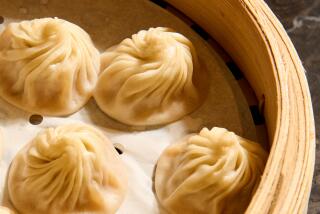A HIGH SCHOOL OF THE PERFORMING ARTS : FU HSING SCHOOL: ‘FAME’ TAIWAN-STYLE
- Share via
TAIPEI, Taiwan — By going from class to class at the Fu Hsing Dramatic Arts Academy, a curious visitor soon gains a sense of the overlapping techniques and traditions of the mind-boggling 19th-Century performance idiom called Peking Opera.
In the kind of mythic melodrama that the Fu Hsing company will perform in Plummer Auditorium, Cal State Fullerton, at 8 p.m. Thursday, and in Ingalls Auditorium, East Los Angeles College, at 7:30 p.m. Saturday, there isn’t time to sort out the theatrical components: vocal music and dancing, acting and acrobatics, masklike makeup and opulent costuming. Throughout, a virtual explosion of piercing sound and brilliant color occurs and it’s hard enough to follow the plot--even with projected English subtitles.
Happily, any confusion quickly vanishes at the Fu Hsing campus in suburban Taipei, since the disciplines of Peking Opera are taught one by one. Students enroll here from age 8 for up to 8 years of training and they must also master the standard curriculum of their non-performing peers. Thus, despite the exoticism of their metier, the Fu Hsing Academy represents something familiar to us: a high school of the performing arts--”Fame,” Taiwan style.
Currently, 332 students attend the Fu Hsing Academy and school officials contend that 60% of the graduates will find careers in Peking Opera. There are now five Peking Opera companies on Taiwan--four sponsored by the armed services and one by the Ministry of Education--plus clubs and performing groups of varying professionalism.
Though Peking Opera otherwise differs from opera in the West, singing is a crucial element. Thus, in one small Fu Hsing vocal class, girls in orange school uniforms take turns practicing the reedy croon of a young male hero in a historical drama. Gender-switching is one of this idiom’s traditions, though teachers explain that new social attitudes make boys reluctant to specialize in women’s roles.
Down the hall, a small boy wearing a cap with a horsetail fall on top, a long false beard, a blue robe and platform shoes that raise him by half a foot fiercely sings a throaty character solo. As he grows increasingly red in the face from his exertions, the instructor beats out the rhythm with a bamboo cane and occasionally corrects the boy’s stance with it too.
Nearby, in a larger mirrored room, eight girls walk on their toes, simulating the characteristic gait caused by Chinese foot binding. Their feet have been wrapped in cloth strips, with wooden heels placed at the tips that cause each foot to resemble a delicate hoof. No, the girls say (when asked), this doesn’t deform their feet, but it does hurt at first. Just like pointe dancing in Western ballet.
Avoiding the blare of an orchestra rehearsal, you visit instead the run-through of a battle scene, performed by a dozen students in a small campus auditorium. Acrobats vault onto the stage with cartwheels topped off by somersaults, each new entrant fighting his predecessor as the others watch from the rear of the stage.
After repeating an especially difficult side-vault, everyone practices vaulting in pairs. The stage fills with stylized combat: A girl with a tassled pike fends off the swords of four boys, making a martial art of baton-twirling. Four more boys challenge four girls, each warrior wielding two swords. It’s all very dance like --but not actually dancing. That’s being taught somewhere else on campus.
Four days later, all the components unite again when the Fu Hsing company performs in downtown Taipei. The young cast (the oldest is 18) performs with enormous energy, if not always with ideal control or perfect ease, and the audience loudly cheers after especially intricate vocal passages.
Scenery is Spartan and stage props are immediately removed when no longer needed. Bright, uncolored lighting leaves the elaborate face-painting and bold costume colors overwhelmingly vivid.
One black silk robe features an enormous dragon densely embroidered in metallic gold. Each scale on the dragon’s body is meticulously defined in tiny stitches, but such gold-on-gold detail becomes invisible from even the first row of the theater--lost in the sheen.
Like Peking Opera itself, this is splendor on the edge of fanaticism: enormous expense and impeccable craftsmanship devoted to an awesome and heedless magnificence.
More to Read
The biggest entertainment stories
Get our big stories about Hollywood, film, television, music, arts, culture and more right in your inbox as soon as they publish.
You may occasionally receive promotional content from the Los Angeles Times.









